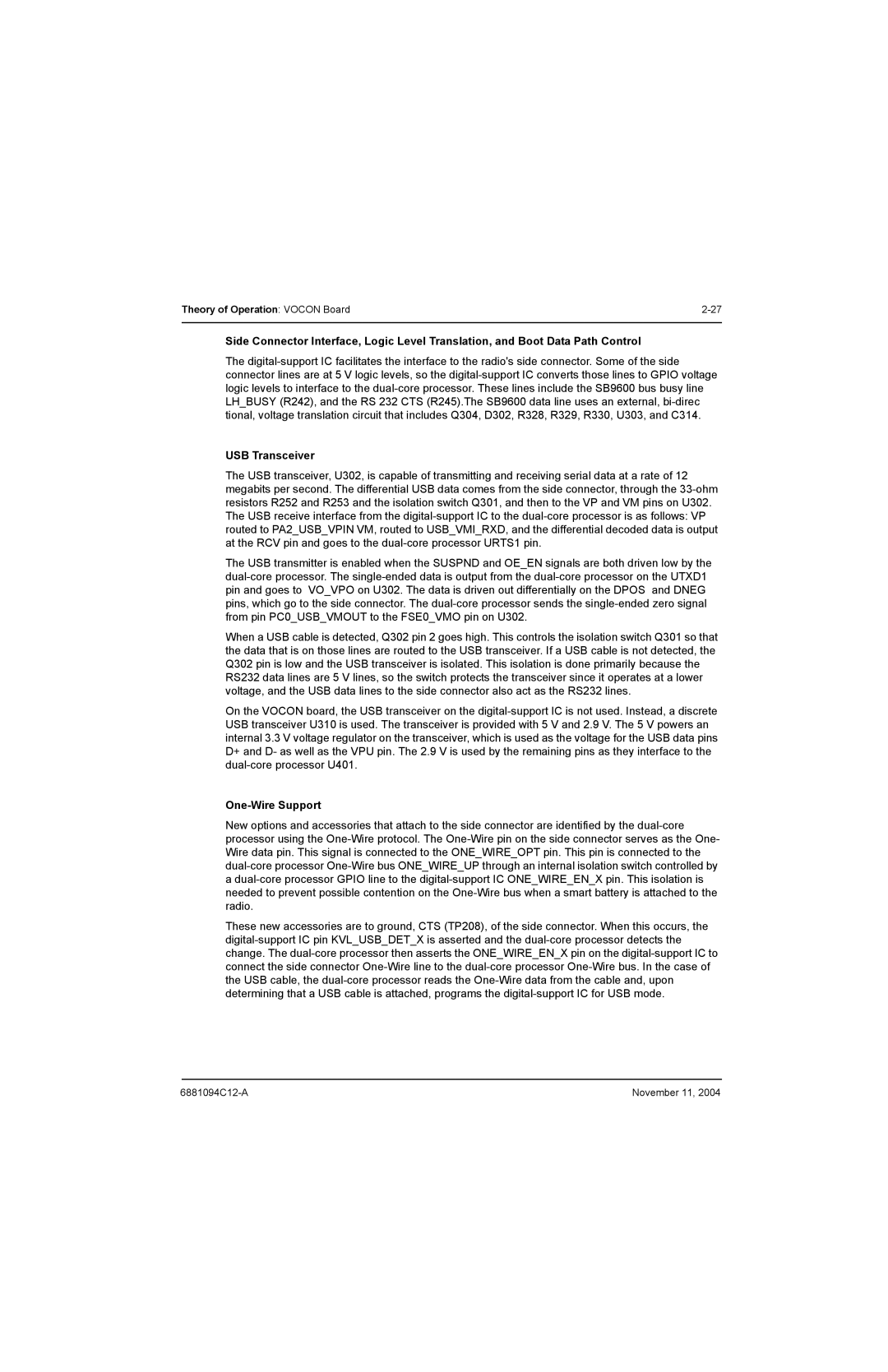Theory of Operation: VOCON Board | 2-27 |
| |
Side Connector Interface, Logic Level Translation, and Boot Data Path Control
The digital-support IC facilitates the interface to the radio's side connector. Some of the side connector lines are at 5 V logic levels, so the digital-support IC converts those lines to GPIO voltage logic levels to interface to the dual-core processor. These lines include the SB9600 bus busy line LH_BUSY (R242), and the RS 232 CTS (R245).The SB9600 data line uses an external, bi-direc tional, voltage translation circuit that includes Q304, D302, R328, R329, R330, U303, and C314.
USB Transceiver
The USB transceiver, U302, is capable of transmitting and receiving serial data at a rate of 12 megabits per second. The differential USB data comes from the side connector, through the 33-ohm resistors R252 and R253 and the isolation switch Q301, and then to the VP and VM pins on U302. The USB receive interface from the digital-support IC to the dual-core processor is as follows: VP routed to PA2_USB_VPIN VM, routed to USB_VMI_RXD, and the differential decoded data is output at the RCV pin and goes to the dual-core processor URTS1 pin.
The USB transmitter is enabled when the SUSPND and OE_EN signals are both driven low by the dual-core processor. The single-ended data is output from the dual-core processor on the UTXD1 pin and goes to VO_VPO on U302. The data is driven out differentially on the DPOS and DNEG pins, which go to the side connector. The dual-core processor sends the single-ended zero signal from pin PC0_USB_VMOUT to the FSE0_VMO pin on U302.
When a USB cable is detected, Q302 pin 2 goes high. This controls the isolation switch Q301 so that the data that is on those lines are routed to the USB transceiver. If a USB cable is not detected, the Q302 pin is low and the USB transceiver is isolated. This isolation is done primarily because the RS232 data lines are 5 V lines, so the switch protects the transceiver since it operates at a lower voltage, and the USB data lines to the side connector also act as the RS232 lines.
On the VOCON board, the USB transceiver on the digital-support IC is not used. Instead, a discrete USB transceiver U310 is used. The transceiver is provided with 5 V and 2.9 V. The 5 V powers an internal 3.3 V voltage regulator on the transceiver, which is used as the voltage for the USB data pins D+ and D- as well as the VPU pin. The 2.9 V is used by the remaining pins as they interface to the dual-core processor U401.
One-Wire Support
New options and accessories that attach to the side connector are identified by the dual-core processor using the One-Wire protocol. The One-Wire pin on the side connector serves as the One- Wire data pin. This signal is connected to the ONE_WIRE_OPT pin. This pin is connected to the dual-core processor One-Wire bus ONE_WIRE_UP through an internal isolation switch controlled by
adual-core processor GPIO line to the digital-support IC ONE_WIRE_EN_X pin. This isolation is needed to prevent possible contention on the One-Wire bus when a smart battery is attached to the radio.
These new accessories are to ground, CTS (TP208), of the side connector. When this occurs, the digital-support IC pin KVL_USB_DET_X is asserted and the dual-core processor detects the change. The dual-core processor then asserts the ONE_WIRE_EN_X pin on the digital-support IC to connect the side connector One-Wire line to the dual-core processor One-Wire bus. In the case of the USB cable, the dual-core processor reads the One-Wire data from the cable and, upon determining that a USB cable is attached, programs the digital-support IC for USB mode.
